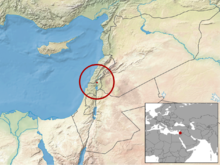Israeli disc beater
| Israeli disc beater | ||||||||||||
|---|---|---|---|---|---|---|---|---|---|---|---|---|

Israeli disc beater ( Latonia nigriventer ) |
||||||||||||
| Systematics | ||||||||||||
|
||||||||||||
| Scientific name | ||||||||||||
| Latonia nigriventer | ||||||||||||
| ( Mendelssohn & Steinitz , 1943) |
The Israeli disc beater ( Latonia nigriventer , syn .: Discoglossus nigriventer ), also sometimes referred to as the Palestinian disc beater , Hulesee disc beater or black-bellied disc beater (sometimes colloquially also simply called the hula frog ), is a frog from the Alytidae family . By 2012, belonged kind in the family of Disc- (Discoglossidae). However, due to new genomic and morphological investigations , the systematic classification of the genus of the actual discoglossus ( Discoglossus ) is now considered questionable (see section Systematics). The species was discovered in 1940 and scientifically described in 1943. It was considered extinct for 56 years before being rediscovered in November 2011.
features
The Israeli disc beater reaches a head-trunk length of about five to eight centimeters. The top is colored ocher and rust-red. On the sides the color turns into a dark olive gray and towards the belly it is gray-black. Similar to Discoglossus species, it also has large, dark, light-lined spots on the back and a round tongue. The dark underside is stippled with white dots. Compared to the other species of the genus Discoglossus , the Israeli disc beak has a larger inner pupillary distance, longer forelegs and a less protruding snout.
Habitat and way of life
The species' habitat is the marshes and wetlands along Lake Hules in Israel . Another population has been suggested in the nearby Golan Heights in Syria ; however, this has never been confirmed. Little is known about the way of life. A captured frog is known to be nocturnal. During the day he buried himself in the sand or peeked out of the water with his head.
status
Between the discovery and the presumed extinction of the species after 1955, only five specimens have been spotted (two females, one juvenile and two tadpoles ). As part of the intensive agricultural use of Huleebene were marching and wetlands 1951-1958 except for small remnants drained. This led to the destruction of the habitat and thus to the extensive decline of this frog species. After it could not be proven for a long time, it was officially listed in 1996 by the IUCN in the "extinct" category.
In 2000, a scientist from the Lebanese nature conservation organization “A Rocha Lebanon” reported that he had seen a frog in the Aammiq swamps, a nature reserve south of the Bekaa plain in Lebanon, which fits the description of Discoglossus nigriventer . However, two Lebanese-French-English expeditions in 2004 and 2005 did not bring any results about the continued existence of the Israeli disc beater.
On November 15, 2011, an employee of the Israel Park and Nature Authority (IPNA) discovered a female specimen in the Hula Nature Park. Another specimen was discovered on November 29, 2011. In the meantime there are plans to renature parts of the Hule Plain and restore the original swamp habitat in order to ensure the survival of the Israeli disc beater.
Systematics
The Israeli discotch was first assigned to the genus Discoglossus , which occurs mainly in countries and on islands in the western Mediterranean region of Europe and north-west Africa. However, more recent studies on genetic and morphological foundations have come to the conclusion that the Israeli disc beater differs greatly from the other Discoglossus species and is more closely related to the frog genus Latonia , which has been extinct for about a million years and is from the Oligocene to the Pleistocene in Europe happened. It turned out that this supposedly extinct frog species not only survived, to the surprise of the researchers, it also turned out to be a living fossil . The Israeli disc beater was therefore given the scientific name Latonia nigriventer .
literature
- David Day: The Doomsday Book of Animals. Ebury Press, London 1981, ISBN 0-670-27987-0 .
- Heinrich Mendelssohn, Heinz Steinitz: A new frog from Palestine. In: Copeia. Volume 4, December 31, 1943, JSTOR 1438135 .
Individual evidence
- ↑ Haaretz article with photo (accessed on November 17, 2011) Long thought extinct, Hula painted frog found once again in Israeli nature reserve
- ↑ Haaretz.com: Second of frog species long thought extinct found in Israel nature reserve on November 29, 2011 (accessed November 29, 2011)
- ↑ a b Rebecca Biton, Eli Geffen, Miguel Vences, Orly Cohen, Salvador Bailon, Rivka Rabinovich, Yoram Malka, Talya Oron, Renaud Boistel, Vlad Brumfeld, Sarig Gafny. The rediscovered Hula painted frog is a living fossil. Nature Communications, 2013; 4 DOI: 10.1038 / ncomms2959
- ^ Darrel R. Frost: Latonia nigriventer (Mendelssohn & Steinitz, 1943) . Amphibian Species of the World: an Online Reference, Version 6.1, American Museum of Natural History, New York 1998-2020, accessed June 25, 2020.
Web links
- Darrel R. Frost: Latonia nigriventer (Mendelssohn & Steinitz, 1943) . Amphibian Species of the World: an Online Reference, Version 6.1, American Museum of Natural History, New York 1998-2020, accessed June 13, 2020.
- ARKive - The first photos of Discoglossus nigriventer
- Expedition report from South Lebanon, April 2005 (English; PDF)
- Latonia nigriventer in the endangered Red List species the IUCN 2010. Posted by: Papenfuss et al. , 2004. Retrieved November 17, 2011.
- Reuters Frog jumps back from extinction in Israel
- ntv: Scheibenzüngler has risen
- Video about the Israeli disc beater

